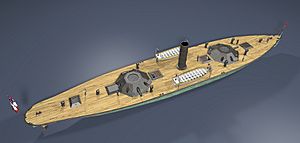CSS Wilmington facts for kids
class="infobox " style="float: right; clear: right; width: 315px; border-spacing: 2px; text-align: left; font-size: 90%;"
| colspan="2" style="text-align: center; font-size: 90%; line-height: 1.5em;" | 
|} CSS Wilmington was a powerful warship called an ironclad that was being built for the Confederate States Navy during the American Civil War. She never got an official name, so historians call her Wilmington after the city where she was built. The Wilmington was still being constructed when the Battle of Wilmington happened in February 1865. To stop her from being captured by Union soldiers after their victory, she was burned.
Contents
| History | |
|---|---|
| Name | Wilmington |
| Namesake | Wilmington, North Carolina |
| Builder | Berry Brothers shipyard, Wilmington, North Carolina |
| Laid down | 1864 |
| Fate | Burned, c. 22 February 1865 |
| General characteristics | |
| Type | Casemate ironclad |
| Length | 233 ft 4 in (71.1 m) (o/a) |
| Beam | 41 ft (12.5 m) |
| Draft | 9 ft 6 in (2.9 m) |
| Depth | 12 ft (3.7 m) |
| Installed power | 4 × boilers |
| Propulsion | 2 × propellers; 2 × geared direct-acting steam engines |
| Armament | 2 × guns |
Building a New Warship
The Wilmington was designed by John L. Porter, who was the Chief Naval Constructor for the Confederacy. She was meant to replace two other ironclads, the CSS North Carolina and the CSS Raleigh. These ships were used to defend the Cape Fear River in North Carolina in 1864.
Unlike the older ships, the Wilmington might have been designed to actively fight Union ships that were blocking the coast. Her sleek shape and strong engines suggest she was built for more than just defense.
Ship's Size and Design
The Wilmington was planned to be about 223 feet 4 inches (68.1 m) long. She would have been 41 feet (12.5 m) wide and sat 9 feet 6 inches (2.9 m) deep in the water. Her total depth was 12 feet (3.7 m). We don't know her exact weight because she was destroyed before she could be launched into the water.
The ship was designed with two small pilot houses, one at the front and one at the back of the armored section. These pilot houses were shaped like small pyramids.
Engines and Power
The Wilmington was going to be powered by two special steam engines. These engines would have turned two propellers, each about 8-foot (2.4 m) wide. The engines got their power from four large boilers.
All the engine parts were made in Columbus, Georgia. However, they were not delivered before the Wilmington was destroyed.
Weapons and Armor
The ship's main weapons were two large guns. Each gun was placed on a special turning mount inside a small, eight-sided armored room. Each of these rooms had seven openings for the guns to fire through. We don't know how thick the Wilmington's iron armor was.
Construction and Final Moments
Stephen Mallory, the Confederate Secretary of the Navy, asked John L. Porter to visit Wilmington, North Carolina in May 1864. This was after the two earlier ironclads built there were lost or became useless. The Raleigh got stuck and was wrecked on a sandbar on May 7. The North Carolina had problems because the wood in her hull was rotting and being eaten by shipworms.
Porter quickly created his design for the Wilmington. Construction began at the Berry Brothers shipyard, which was on Eagles Island across the river from the city. Some reports say that the Wilmington used armor that was saved from the two older ironclads.
However, the Wilmington was still being built when Union troops captured the city on February 22, 1865. To stop the Union from getting their hands on the ship, the Confederate troops burned her as they retreated.
Images for kids



